==================
A Caveat and Affiliates
First off, a little caveat: within my articles you will find affiliate links, meaning if you buy them, I get a small commission. Your cost is not affected. In addition, I am an Amazon Associate and I earn from qualifying purchases on Amazon.
And yes, if I say that I recommend a product here, it means I truly believe it is a good product. I refuse to recommend any product that I have not researched and believe to be a good value.
Even better, I provide you with a very clear picture of the product, it’s use, and the probable value.
Earning your trust is important to me. I run this website myself and the commissions and donations help support the site.
Sound reasonable and fair enough? Let’s continue to the article.
==================
15 Easy Fruits and Vegetables to Grow in Pots
The many difficulties brought about by the pandemic have most of us re-think our priorities. One of which is being self-sufficient as regards food and sustenance. Not only that. It’s relying more on foods that can be grown right in our backyard garden. Think fruits, seeds, nuts, herbs, mushrooms, vegetables to grow in pots, and many more nutritious plant foods.
Citrus fruits, tomatoes, cucumbers, and just about anything else you’d ordinarily plant in a larger garden are among them. The difference is that because they’re all in containers, you can grow them on your deck, porch, or wherever you have space. Plus, because these crops thrive in containers, you won’t have to worry about obtaining smaller-than-average tomatoes. You’ll get a large beefsteak tomato in a container if you ask for one.
Now, here are the 15 easy fruits and vegetables to grow in pots:
Lettuce
Since lettuce requires less growing area than head or stalk lettuces, looseleaf and romaine lettuces are the most delicate lettuce species to grow in containers. The optimal soil mix for growing lettuce in pots combines peat or compost, soil, and perlite to prevent the lettuce from drying out. Seeds should be sown shallowly, no more than a half-inch deep. Maintain moist but not damp soil.
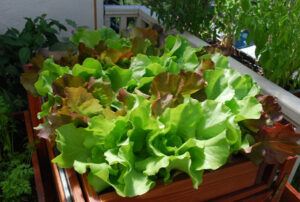
Basil
Rejoice, pesto lovers. This culinary herb is one of the easy fruits and vegetables to grow in pots. Once all dangers of frost have gone, basil may be cultivated from seed or young seedlings outside. Basil thrives on rich organic materials, so add more compost to your pot. Put your basil plant in broad light and water it once a week if the weather is dry. To increase the duration of the harvest, pinch off the blossoms or tips of each stem before it flowers.
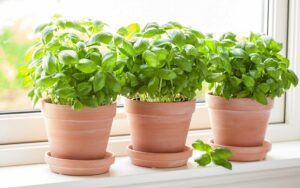
Chives
This onion-flavored tiny plant is best grown from seed in a container. Chive seeds should be sown 14 inches deep. Seeds should be spaced 4 to 5 inches apart. It will take 10 to 15 days for the seeds to germinate. If not cut, chive leaves can grow 10 to 12 inches long. Snip an inch or two from the tips of fresh chives using kitchen scissors as required. Bring the pot indoors throughout the winter, or any time there is a possibility of frost. Chives thrive on a sunny windowsill indoors.
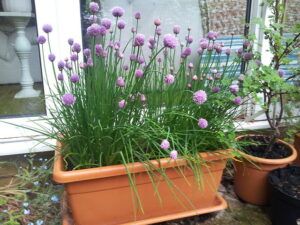
Tomatoes
Tomatoes may be grown in pots outside after overnight temps hit the mid-50s, whether you’re growing seeds or young seedlings. Container-grown cherry and grape tomatoes and smaller kinds like patio hybrid, Small Fry, and Tiny Tim are ideal. In a 5-gallon container, one tiny variety of plants may be cultivated. Stakes or tomato cages should be used when growing bigger tomato types in a 25-gallon container, such as half-barrel, full-size plant varieties. When planting, fertilize the soil and water the plant immediately. After that, only water the plants that have begun to wilt. Tomatoes love the heat. Mulch four to six weeks after planting in a huge half-barrel container. Mulching is postponed to allow the soil to warm up.

Snow Peas or Sugar Snap Peas
Growing these peas has a lot of advantages. The pods of both plants are edible, which means increased production and no shelling. Choose a sunny spot for your window box, a half barrel, or another container. Plant seeds in well-drained soil at a depth of approximately 1 inch, 3 to 4 inches apart. Throughout the growth period, these vining plants will require assistance. You may keep the vines off the ground and at eye level by using a trellis in a container, a tomato cage, or a bamboo teepee fixed in the soil. In the spring, keep an eye out for caterpillars. The vines may grow up to 5 feet tall.

Peppers (Bell or Chili)
Sweet bell peppers and fiery chili peppers not only give color to your patio garden but also offer aesthetic appeal to your culinary meals. Peppers are easy to cultivate in pots since they grow straight and generate large yields while occupying little room on your balcony. For container planting, use compact bell pepper cultivars or add tomato cages into a deep 14-inch pot to support taller plant species. Hot peppers grow in a more compact form, ideal for container gardening.
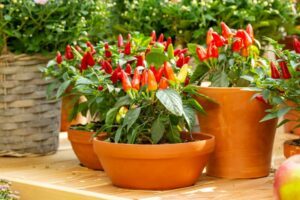
Zucchini
Growing zucchini requires a lot of space, but if you have limited space, putting them in pots is a terrific alternative – miniature types perform incredibly well for this. Avoid using conventional garden soil, which might suffocate the roots, and instead use lightweight potting soil. Two to three seeds, about an inch thick and 3 inches apart, should be planted in the center of the container. Until the seeds sprout (about 1-2 weeks), water the soil and keep it damp (but not saturated). If all of your seeds sprout, thin them out and keep the strongest seedlings. Ensure the plants get plenty of sunlight—at least 10 hours a day is ideal—and use stakes or tomato cages to support the vines. The plants should be fed every four weeks.
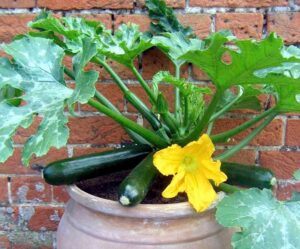
Strawberries
Beautiful terra cotta pots, barrels, tiered planters, and hanging baskets may be used to cultivate this delectable fruit on your deck or patio. One strawberry plant will fit in a 3- to 4-inch planter. Three to five plants can fit in a hanging basket. Add a layer of mulch on top of the soil to prevent heat damage to the roots, and avoid growing strawberries in gloomy pots. Strawberries have little root balls that spread out in all directions, so be sure to bury the roots thoroughly. Strawberries can not flourish in damp soil; therefore, good drainage is essential.

Radish
Do you have any experience with container gardening? This is one of the easy vegetables to grow in pots for beginners. It starts from a seed and thrives in full light in various pot sizes. Never let the soil dry up; keep it wet to avoid bolting. Radishes don’t need to be fertilized very often. To allow roots to develop beneath the ground freely, choose deep pots. Seeds should be sown at a depth of one-half to one inch.

Microgreens
This fast-growing blend of very healthy and delicious greens should be in your edible container plant collection. Microgreen seeds should be distributed on the surface of a vermiculite-rich soil mix in domed-lid growth trays. Cover seeds lightly with soil mix and place them on a covered porch or patio where they will be protected from the elements. Depending on the seed variety and growth circumstances, microgreens are available to harvest about 2-4 weeks following germination. When the young sensitive plants reach a height of 1-3 inches, harvest them with scissors at first or during the early leafing stage. They’re great in salads and sandwiches.
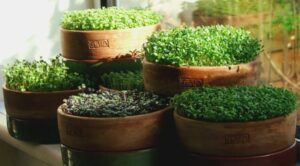
Parsley
Parsley is one of the easy fruits and vegetables to grow in pots. So, if you love adding fresh parsley to your dishes, this is the perfect herb to grow on the balcony or porch. Parsley grows well in small pots and requires just partial sunshine, making it an ideal meal ingredient for growing in flats or other compact places. Keep the soil wet and avoid overwatering your plants for excellent results. It thrives in temperatures ranging from 40 to 80 degrees, making it ideal for winter container gardening. Just remember to bring it inside at night to keep it from becoming too chilly.
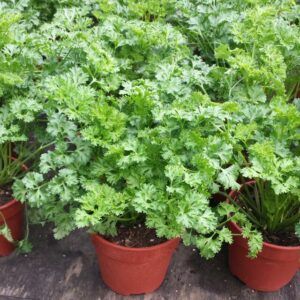
Oregano
For beginners, oregano is a popular choice for easy vegetables to grow in pots since it thrives in various containers. Planting oregano in a container helps to restrict it from spreading. That’s why most experienced gardeners advocate using containers if you want to keep your oregano under control. Each plant only needs a tiny container and a modest amount of potting soil. Oregano is an easy plant to cultivate and is quite hardy, so you should have no problem getting it to flourish. If you’re growing oregano in the winter, choose a bright area to place it in during the day and then bring it in at night.

Rosemary
Having an herb garden does not require a vast garden area. Many herbs may be grown in pots, and rosemary grows particularly well in this setting. Choose potting soil with the least amount of peat moss possible. Rosemary favors an alkaline pH; therefore, the acid is beneficial to its growth. There should be some sand in the bottom of the container for drainage, and the surface should be allowed to dry out a little between waterings but never fully dry.
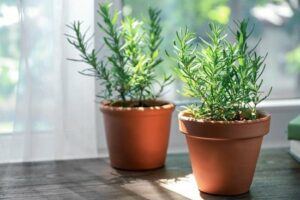
Spinach
Spinach is exceptionally healthful and grows nicely in containers. For each spinach plant, you’ll need an 8-inch pot. Remember that spinach is heat-sensitive, so keep it out of direct sunlight to avoid withering. Containers may get rather hot during the summer, so pick a cool, shady location for them outside. You may also grow spinach indoors, thriving in the colder months. However, it would be best to keep them adequately hydrated during the winter to prevent them from drying out due to the indoor heat.

Thyme
Thyme is another herb that does well in containers and may be grown indoors and out. If you like, you may create an herb garden in pots and plant your thyme among basil, oregano, and other herbs, or have a thyme-only container. Thyme grows best in clay pots since they don’t dry up between waterings. If you overwater thyme, it will not grow properly, so be sure to use a container with a drainage hole at the bottom. During the winter, you may grow it indoors, but it’s best to give it some fresh sunshine during the spring and summer.

Conclusion
In summer, one of the things that give satisfaction is stepping into your kitchen with a colander brimming with home-grown produce. Harvesting your food with origins you can trust is a thrilling experience. And there’s no reason a lack of space should prevent you from doing so. And your living areas, patios, and terraces could also be enhanced with potted trees. Since a potted tree is usually taller and bigger, it’s the only decorative plant to fill an empty nook or corner.
To produce your food, you don’t need to dig out a large area in your garden. You may grow an edible container garden despite the limited space on your porch or patio. Growing veggies in pots offers a world of options, and you may even plant and harvest unusual and delicious types that you wouldn’t find at the supermarket.
Even if you only have a balcony, a patio, or a little garden, you can still fill it with delicious foods that taste not only great but also look amazing as they develop. Position a few pots by your front or back door. Plant one of these easy fruits and vegetables to grow in pots. It’s easy to keep an eye on them, which will help you stay on top of any pests and diseases.
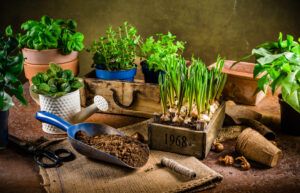
READ MORE
